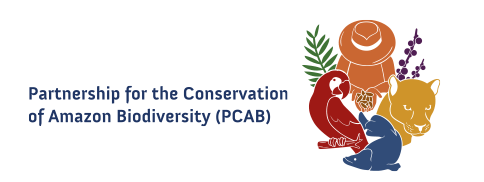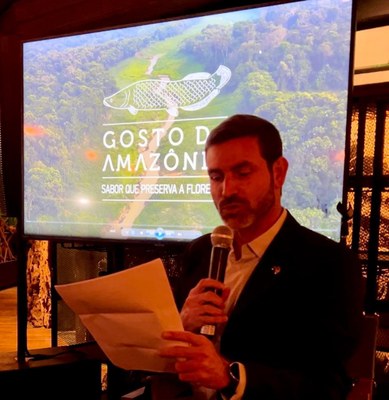‘Gosto da Amazônia': Biodiversity Conservation and Income Generation
May/June, 2024 – Francisco Alessandro lives in the Xibauazinho riverine community, in the municipality of Carauari, located in the heart of the Amazon. He works on the sustainable management of one of the largest freshwater fish in the world. Native to the Amazon biome, the pirarucu contributes to the preservation of its ecosystem and generates income for fishing communities. Alessandro’s work as a fisheries manager helps conserve this species and the wealth of local biodiversity.
Due to predatory fishing, the pirarucu was listed as a threatened species in the 1980s and early 1990s – but thanks to the work of riverine and Indigenous communities, especially in the Médio Juruá region, its populations have now increased. Those efforts led to the creation of a collective brand named ‘Gosto da Amazônia’ (Taste of the Amazon), which celebrated its fifth anniversary with a dinner in São Paulo, a metropolis more than 3,000 kilometers from Carauari. That was the distance traveled by Alessandro—by boat and by plane—to speak about how the income generated by fishing has changed his life and the lives of his community.
“Thanks to this new source of income (from sustainable pirarucu management), we were able to fulfill one of our biggest dreams: installing healthy and sustainable solar energy in our communities. In the past, we only had electricity for a few hours, but now our power supply lasts much longer, which is very gratifying.” After his address, participants were invited to feast on a special meal made with Amazon ingredients by chefs Filipe Leite and Priscila Deus, who visited the Médio Juruá in 2022. The tasting menu included pirarucu croquette for starters; an entree of grilled pirarucu loin with cassava puree, plantain, and tucupi sauce; and a cocktail made with jambu flower.
‘Gosto da Amazônia’ – a production and commercial arrangement led by the Associação dos Produtores Rurais de Carauari (ASPROC) – was supported by USAID since launching. The work is completed without intermediaries. Association members manage the signing of contracts with local fishers, transportation arrangements to and from management areas, and processing in the slaughterhouse. Through fair trade practices, better prices are guaranteed for more than 200 management communities. Annual sales have reached 300 tons of fish from different regions.
“Gosto da Amazônia is a collective brand that represents the work of many people and organizations. It is innovative because it emerged from a community association. The people involved in the project understand that they are contributing to the conservation of nature,” said Pedro Constantino, thematic coordinator for the United States Forest Service (USFS).
In addition to the USFS and USAID, the dinner brought together other partners and supporters, including the Native Amazon Operation (OPAN) and the Rio de Janeiro Bars and Restaurants Union (SindRio).
Marcos Bauch coordinates the USAID South America Program in Brazil. He highlighted the experience of getting to know the project up close, recalling his visit to the Médio Juruá together with chefs from various parts of the country to observe pirarucu fishing (read more about it here).
“It was a life-changing experience for everyone involved: we learned about the history of the region; saw where the food we eat comes from; witnessed pirarucu counting and fishing; observed how the community’s organization delegated tasks to ensure successful fishing; had close contact with the logistical difficulties that communities face; and were able to talk and get to know the people of São Raimundo (one of the managing communities). I am eternally grateful for this opportunity,” said Bauch.
Lilian Gonçalves da Silva, a fishing manager from the Médio Solimões area, traveled to São Paulo for the first time, and highlighted the role played by women. “The participation of women is key for the sustainable management of pirarucu. We work together—men, women and young people—to guarantee a better future for ourselves and for nature. We manage to reap benefits without harming the environment, ensuring our sustainability.”
According to 2022 data released by ASPROC (latest figures available), almost half of the 750 people managing fishing in the Médio Juruá region were women. In addition to cleaning and removing fish entrails and counting the fish, more and more women are now occupying leadership positions.
Management – Throughout the year, the communities that participate in pirarucu sustainable management monitor the natural environments where this species is found to avoid predatory fishing. Under management arrangements, fishing is authorized by the Brazilian Institute of the Environment and Renewable Natural Resources (IBAMA) during the dry period (between September and November), respecting the pirarucu's reproductive cycle.
Only 30% of the adult pirarucu population may be fished in each managed lake to enable a progressive growth in the number of fish. “For us in the Médio Juruá territory, pirarucu is more than a fish. It is a gift that nature gave us, and that we lovingly take care of so that we can continue to have it for future generations," concluded Francisco Alessandro.




